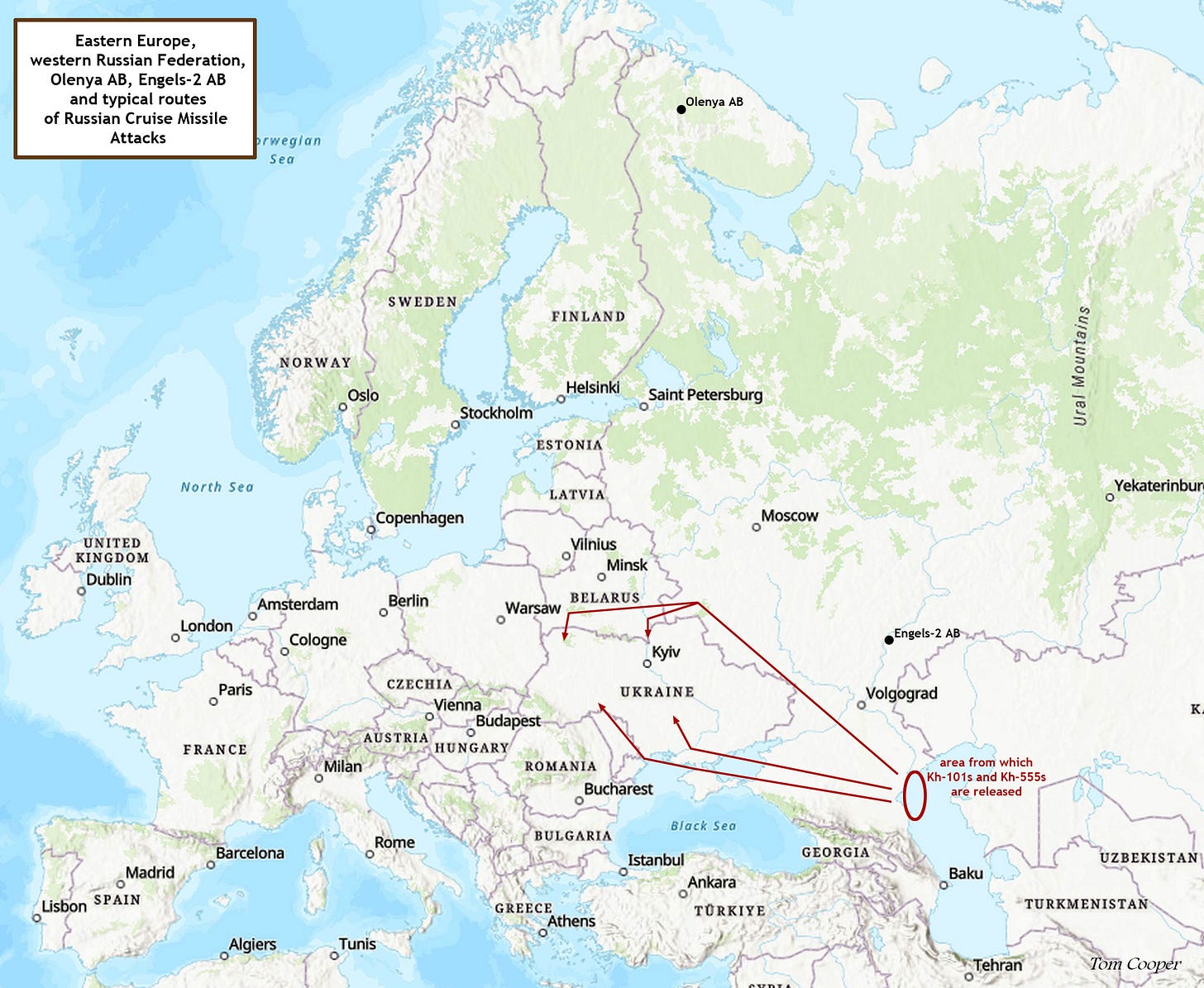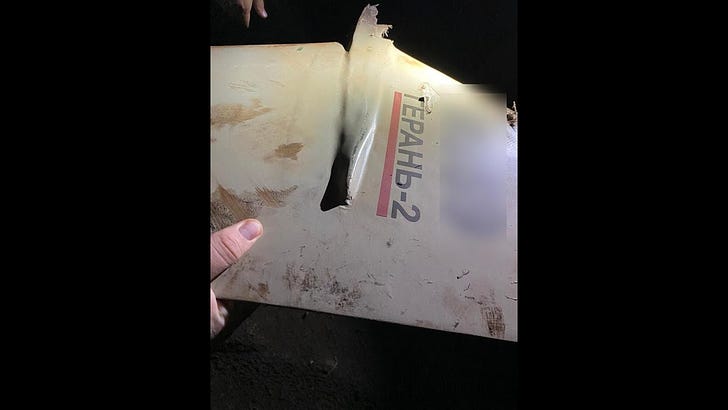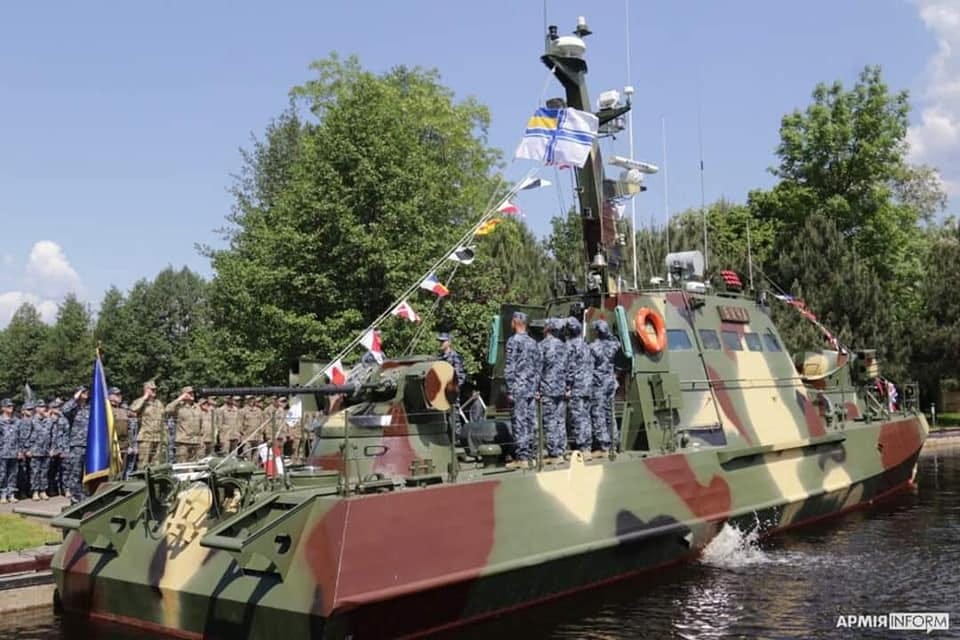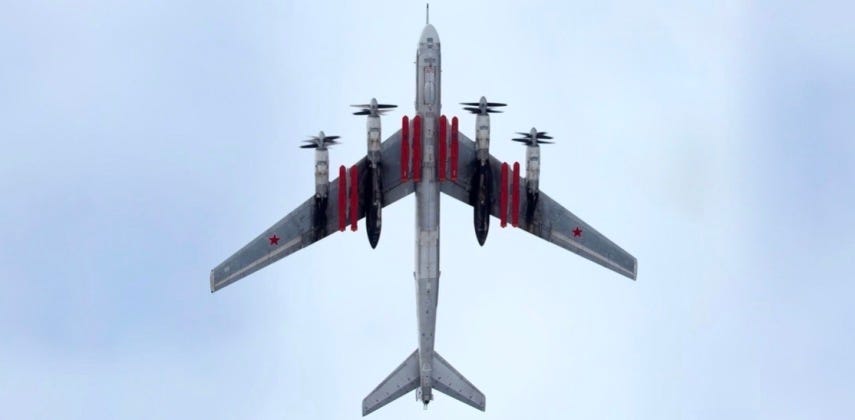Good morning everybody!
As far I can figure out, we’re ‘mid’ through a relatively quiet phase on the ground – but in the middle of a particularly intensive period of air- and missile war.
Think, it’s not wrong to say something like, ‘it began on 25 May’, when two oil pipelines – one in the Tverska, the other in the Pskovska Oblast of Russia – were, reportedly, hit by Ukrainian UAVs. The Russians claimed both UAVs were shot down or crashed without causing any damage.
At 22.00hrs of 25 May, the Russians hit back with a total of
- 17 Kh-101 and Kh-555 cruise missiles, and
- 31 Shahed-131/136 loitering precision guided munitions (LPGMs).
This attack lasted until 05.00hrs in the morning of 26 May. The PSU (Ukrainian Air Force) claimed 10 Kh-101 and Kh-555 cruise missiles, 23 Shaheds, and two supporting reconnaissance drones as shot down (one Orlan-10 and one Merlin-VR) – including all those fired in direction of Kyiv.
Additionally, seven S-300 and/or S-400 SAMs were launched in ballistic mode from a position near Tokmak against ‘critical infrastructure facilities’ in Kharkiv and Dnipropetrovks oblasts. Finally, the Sumy Oblast was attacked by 14 air strikes and fire actions from multiple rocket launchers.
***
On 26 May, apparently, Ukrainians Su-24s hit a unit of the Russian naval infantry in the Mariupol area using Storm Shadows, reportedly ‘just hours after this arrived’. Reports in the Russian social media quoted up to 250 killed. As far as I can say, this was the second strike of this kind in the Mariupol area within a week, and the second with similar – massive – consequences for the VSRF.
***
On 27 May, the Russians retaliated by striking the cultural centre of New York/Niu York in Donetsk by two MPKs (250kg glide bombs): this was empty, but this set up the pattern of their targeting for the last few days: a pattern along which the Russians are targeting ‘big buildings’ – along the frontline but also deeper inside Ukraine.
In the afternoon of 27 May, either a Ukrainian ballistic missile or Su-24s of the PSU then hit an unknown target in Berdyansk.
***
During the night from 27 to 28 May, the Russians released a total of 59 Shahed-131/136s upon Ukraine – and that in two streams, one from the north and the other from the south (apparently: the coast of the Azov Sea). According to the PSU, they were underway in groups, early on, before separating so that each was flying along its own route, descending low enough to exploit the local topography, and with some circling short of the target zone before actually striking: this is said to serve the purpose of ‘misleading the Ukrainian air defence system’. The majority (apparently: some 40) were targeting objects in the Kyiv area.
The PSU first claimed ‘52 out of 54’ Shaheds as shot down; later revised this to 58 out of 59. One Shahed was claimed as shot down by Border Guards unit in Chernihiv, reportedly with ‘small arms fire’:
Another Shahed was claimed shot down by a crew of one of ‘artillery boats’ of the River Flotilla of the Ukrainian Navy, underway in the Kyiv Reservoir – like the vessel Bucha, recently introduced to service:
The one that came through seems to have hit something (‘an infrastructure facility’) in Zhytomyr: what exactly was hit, remains unknown, though. Ukrainians only reported ‘damage to at least 26 houses, as well as educational and healthcare facilities’ - which, if I’m to ask, is ‘slightly too much damage for a single 500kg warhead’. Read: it’s perfectly possible that some of the damage in question was caused by own SAMs - whether those that missed and hit the ground, or their wreckage that fell on the ground after hitting something. In Kyiv, one person was killed and one injured by the falling debris of SAMs and Shaheds.
Additionally, the VKS flew 91 air strikes, and the VSRF run 25 firing actions from multiple rocket launchers. The PSU reported flying 13 air strikes – including two against Russian air defence systems.
***
During the night from Sunday to Monday, 28-29 May, the Russians launched two large-scale missile strikes on Ukraine. According to (revised) numbers issued by official Kyiv, these included a total of
- 40 Kh-101 and Kh-555 cruise missiles (36 were claimed as shot down); and
- 38 Shahed-131/136 LPGMs (30 were claimed as shot down).
(Earlier reports were listing 37 cruise missiles and 29 Shaheds.)
As far as is known, an air-raid warning was sounded around 23.55hrs local time and lasted until 05.00hrs. Related explosions were reported from Kyiv, Lviv, Vinnytsia, Odesa, and Khmelnytskyi Oblast.
In Khmelnytskyi district, a military facility was hit, and five aircraft officially confirmed as ‘disabled’..
Debris (wreckage of Ukrainian SAMs and Russian missiles) is known to have hit a home in Podilskyi district, wounding one, and explosions were reported from the Desnianskyi district. One of incoming missiles was, reportedly, shot down by an Igla MANPAD.
During the afternoon of 29 May, official Kyiv reported that the Russians have launched 11 Iskander ballistic missiles on ‘civilian- and critical infrastructure’ in Kyiv (16 air- and missile strike since 1 May): PSU claimed all 11 shot down.
Additionally, according to official Kyiv, the VKS flew 53 air strikes, and deployed multiple rocket launchers for another 20 strikes – on ZSU positions, and on civilian settlements. No less than 49 explosions were reported from the Sumy Oblast, but the worst known attack was an MPK-strike (250kg glide bomb) on a petrol station in Toretsk, where 2 were killed and 8 wounded. A second MPK hit an administrative building, wounding one.
In turn, official Kyiv claimed to have hit three Russian air defence systems and one ammunition storage depot. The PSU flew 15 air strikes.
***
Now, what can be concluded about all of this?
The mass of claims by both sides cannot but be taken with a pinch of salt. Perhaps Ukrainian air defences are really ‘shooting down whatever comes their way’, but it’s certainly not as easy as this might appear to many, nor are the Russians ‘missing all the time’. On the contrary: when they hit, ‘it hurts’. Finally, one should keep in mind that the mass of Ukrainian population is kept ‘out of their beds’ for something like five nights now: whenever there is an air raid alert, they are advised to go to shelters (even if, apparently, too many are still ignoring this). Obviously, this is creating strong psychological pressure.
That said, it’s not like if the weaponry deployed by the Russians is in the class of ‘super-turbo Wunderwaffen’ as frequently claimed (whether by the Russians, by Pudding’s PR-machinery, by different of famous NATO generals, Truppeninspektors, or Pudding-fans abroad). Kinzhal, for example, turned out to fly much slower in its terminal phase than usually claimed ‘Mach 10’, and to have only minimal manoeuvrability. Reasons are a combination of its solid-fuel rocket engine (which can’t be shut down or throttled in light), and insufficient control systems (not enough to provide capability to make sharp turns, just for example).
This is why since 16 May, the Russians are trying to oversaturate Ukrainian air defences by running simultaneous attacks by multiple different weapons systems (Shaheds, cruise missiles, Iskanders, S-300s, S-400s and Kinzhals) deployed in better-coordinated way than before. In other cases, they are exposing selected parts of Ukraine (foremost Kyiv) to hours-long strikes of Shaheds, so to ‘freeze’ the PSU’s integrated air defence system in one position (prevent it from re-deploying), force it to power up its radars and SAM-sites, and thus find out about its precise location, in turn enabling attacks on Ukrainian air defence positions by additional missiles or LPGMs. Through such operations, the Russians are also preventing the PSU from re-deploying parts of its SAM-sites in ‘assault mode’ against their tactical aviation.
Now, some are jumping to conclusions and – on basis of Ukrainian claims about MIM-104 Patriot shooting down 100% of whatever comes its way – concluding the system is crucial for the high interception rate of Russian missiles. This is creating the impression of ‘Patriot is shooting down everything’ and ‘nothing else (but Patriot) matters’. Something like that it’s a ‘do it all Wunderwaffe’.
….which, brought to the point: is completely wrong.
Crucial factor for effectiveness of the PSU is its ability to integrate very different sensors and weapons systems into one integrated air defence system and to fusion all the intelligence available about related enemy activities and information about incoming missiles. For example: to receive the ‘integrated intelligence- and radar picture’ of western- and southern Russia forwarded to it by NATO, and then ‘integrate’ or ‘fusion’ or ‘merge’ this into or with its own radar picture, so to obtain a good idea about from what directions to expect what kind of an attack – probably hours before this is actually taking place.
This is even more important considering that, for example, the Bomber Aviation of the VKS is meanwhile regularly deploying more bombers than actually necessary to a deploy a (relatively) small number of Kh-101s and Kh-555s reported as deployed.
For example: a single Tupolev Tu-95MS bomber can carry a maximum of 8 Kh-101 missiles (on four double launchers under its wings). Alternatively, it can carry 6 Kh-555 missiles on its rotary launcher inside the bomb bay. Thus, a total of two would be enough to release 16 Kh-101s or 12 Kh-555s. However, the Russians are regularly sending up six or more Tu-95s into a single strike – to release 12-16 missiles.
They do so for multiple reasons.
Firstly, Tu-95MS’ are old aircraft and the Russians must expect one or another to suffer one or another type of technical malfunction preventing it from releasing its cruise missiles. Moreover, loading all the 8 Kh-101s or 12 Kh-555s is adding stress to the airframe. Thus, they’re loading a lower number of missiles per aircraft, to lessen the wear of the airframe. Finally, they’re launching so-called ‘airborne spares’: aircraft whose crew is briefed to complete the mission (and whose aircraft is armed with ‘just’ 2-4 missiles) in the case one of crews actually tasked with the strike is forced to abort.
Secondly, the Russians know that – because bombers like Tu-95 are capable of deploying nuclear weapons – NATO intelligence is tracking every single of their moves. Repeat for emphasis: every single one – including down to such details like, ‘aircraft XY was re-spotted from position A on this air base, to the position B’. Thus, the Russians know that whenever they launch any bombers, NATO is going to inform Ukraine. The more bombers they launch, the more is NATO informing Ukraine. In turn, a larger number of bombers ‘underway towards’ Ukraine along different routes is forcing the PSU to ‘disperse’ its SAM-sites in expectation of attacks from a larger number of different directions, while making it uncertain exactly when are their cruise missiles going to reach Ukraine.
Precisely in this regards there is another important detail to consider: over the last few days and weeks, it became obvious why the ZSU began striking the Engels-2 Air Base (AB), outside Saratov, with UAVs, a few months ago. Engels-2 was not only a major base for Tu-96s, but the sole operating location for supersonic Tupolev Tu-160 bombers. Both Tu-95s and Tu-160s are huge aircraft: they not only need long runways, but the Russians had no hardened aircraft shelters for them even at Engles-2. More importantly: both types are requiring specialised support infrastructure: facilities housing nuclear- and other weapons, but especially spare parts and maintenance equipment. One can’t operate them from ‘some other air base’, even less so ‘just like that’, and especially not over protracted periods of time (see: ‘weeks’ and ‘months’): for this one needs another specialised air base.
Olenya AB is one of such ‘bases specialised in bombers’ - even if many times more distant to Ukraine than Engels-2.

Thus, regardless how ‘ineffective’ (then, apparently, Ukrainians only managed to damage one or two Tu-95s and one Tu-22) Ukrainian UAV-strikes on Engles-2 were highly effective: they have forced the Bomber Aviation of the VKS to re-locate to the Olenya Air Base, on the Kola Peninsula. (Ironically, the Western mass media [here a typical example] entirely missed this point and promptly jumped to the – as usually – wrong conclusion and declared this some sort of a ‘threat’ to Finland, Norway, and Sweden. Actually, this was a technical necessity caused by Ukrainian strikes on Engles-2 AB.)
Actually, the re-location of the big Tupolevs from Engels-2 AB to Olenya AB added another ‘gem’: the latter is much closer to NATO than Engels, and thus the activity of Russian bombers from it is much easier to track by NATO’s intelligence-gathering systems. Read: ever since, NATO can provide even better early warning to Ukraine than it used to be able while they were still at Engels-2 AB…
Another advantage (for Ukraine) from re-location of the Russian bomber fleet to Olenya AB is its distance to Ukraine. Tu-95s are relatively slow and, after taking off, need hours to reach positions – usually above the north-western Caspian Sea – from which they are releasing cruise missiles. The longer they take to reach such positions – the better, for Ukraine. This is adding to the stress and wear of their airframes and, in shorter term, their additional hours of flight (followed by average two hours of flight of their cruise missiles) are enabling the PSU to deploy its SAM-systems into favourable positions.
…of course, whoever wants, has got at least three attempts to explain me that nothing of this matters…
Well, that itch in my small toe is telling me that it is important. Even if problematic: for their proper function, SAM-systems need an ‘open area’. Not only to ‘manoeuvre’ (before the firing action) and thus disperse their elements - and thus avoid a possible attack – but, and especially, to have a ‘free field of fire’. Finding the same inside major cities is, usually, next to impossible, except there are such localities like, just for example (and, meanwhile well-known to the Russians) Sikorsky International Airport. A large, open area quasi ‘in the centre of the city’.
(…hair-splitters are now going to point out, ‘it is not’: be sure, it’s ‘close enough to matter’…).
Another point is that, oversimplified, SAM-systems work ‘the best’ when positioned closely to the area they are supposed to protect: the closer they are to the ‘axis of attack’ (principal direction from which incoming missiles and LPGMs are approaching), the better.
Good selection of positions for SAM-sites is also as important because, once activated and involved in a firing action, SAM-systems can’t be moved: no matter how much ‘mobile’ once disassembled, when assembled and starting to fire, their radars are calibrated to the area in question (even if the crew was in immense hurry) and their launchers are immobile, fixed in position. This is of particular importance during the defence of big cities with tall buildings, chimneys, TV-towers and similar constructions: for example, one does not want some skyscraper to create a ‘blind spot’ in the radar coverage, or some SAM-site to ‘empty’ its launchers into the nearest skyscraper ‘just because its launcher is pointed in ideal direction and the skyscraper was in the way’.
….all of which is why am I characterising all of this as a ‘Game of Angles, Directions and Distances’. Of course, and tragically, it’s also a ‘game’ in which people get killed, and Ukraine is suffering additional damage.






Very interesting article, as usual. I got a question: how is Russia stock of cruise missiles going? I mean: I remember reading one of your articles a few months ago were you guessed the Russian stock of Kh missiles were close to run out. Are russian missiles factories still producing cruise missiles despite the tech import restrictions? Were existing russian missiles in stock more numerous than what was initially forecasted? Is Russia getting more of their Kh missiles back from allies?
🤔
Thanks for your dedication Tom, the quality of your job is very appreciated.
A lot of very useful information as usual. Many thanks for supporting Ukraine. Impatient to know your opinion about the attack at Moscow.